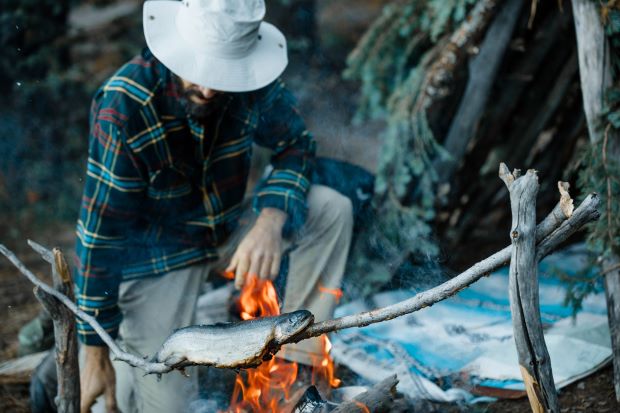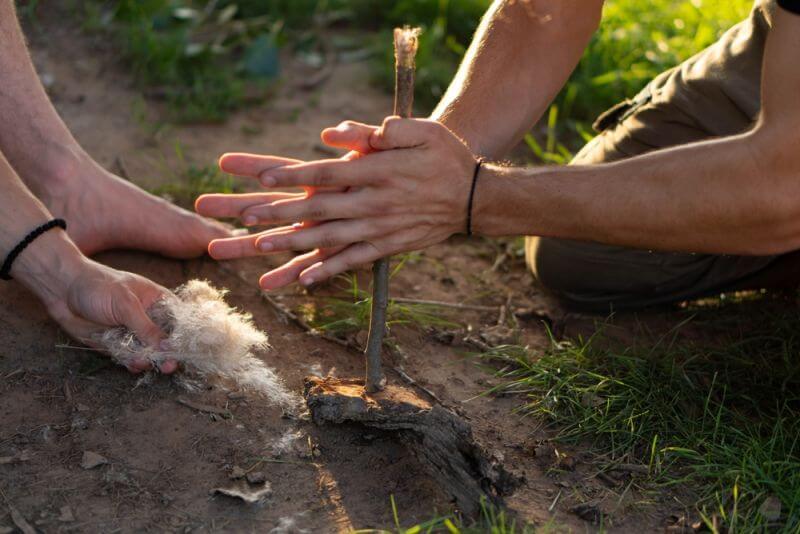Are you an adventurer who likes spending time in nature?
Whether you like hiking, camping, spending time in the woods, or going on safaris in the desert, each activity carries danger with it. You can’t predict if something will happen but what you can do is to be prepared.
Preparedness is half of the job. Knowing what you need to focus on in such situations, what you always need to carry, and what you need to do can save your life. What’s also important is that it can save the lives of your companions as well.
Now, all of you fellow wilderness lovers, read the following tips carefully and you’ll be good to go on the next adventure without any fear.
1. Look for Water
One of the main necessities for survival is water. Without it, you won’t stand a chance. Did you know that you can only live 3 days without any water? That’s how important water is.

Even if you have had some water reserves you are bound to run out of them and then you’ll be left with nothing. That is why you need to know how to look for water and where you can find it. Here are a few tactics for collecting water that you can apply:
- Collect
dew with your shirt. Use your
shirt to collect dew by pressing it onto the ground. Then wring the shirt and
drink the dew directly or pour it into the water bottle. - Drag a
piece of cloth through the woods.
Tie it to your leg and keep walking through the woods. The dew from the plants
will be absorbed by the cloth. - Let
the ants guide you. When you
come across a train of ants going up the tree there is probably a water source
there. Look for a crotch in the tree where they are going in, and put a piece
of clothing in there to collect water. You can also look into the holes of
decaying or dead trees. - Go parallel
to the mountain. When there is
a mountain there is usually a stream there somewhere. Just walk parallel to the
mountain and you will come across a source of water. - Dig in
the dry stream or river beds.
The water should be below the surface. The best place to dig is on the outside
edge. - Look
under the rocks. Rocks slow
down the evaporation process so there might be some dew left under them. Just
before the dawn is the perfect time to turn over every rock you find and
collect moisture with a cloth. - Eat
cactus fruit. If you find
yourself in the dessert look for prickly pear cactus pads or barrel cactus
fruit. They are safe to eat and contain lots of water that your body will
desperately need.
2. Boil the Water
If there is a river, lake, pond, or a stream you will have a source of water. But the water you will find there is dirty and needs to be sterilized. For this, you’ll need a metal container that you can put onto the fire and let the water boil. The water needs to be boiled for at least 20 minutes.
“I have learned from a young age that steady water sources aren’t clean enough for us to drink from. That’s why we shouldn’t drink directly from them. If you don’t have a water filter on you, find a way to sterilize water,” said Jason DuBois, a digital marketer at BeGraded and passionate adventurer.
Even though using a metal container is the easiest option, there is another solution. You can make a boiling pit. Here is what you need to do:
- Dig a hole next to your campfire (length and width approximately 2 feet (0.61 m) and depth approximately 2 feet (0.61 m))
- Separate the soil and the clay (clay is reddish and sticky)
- Put the clay all around the hole so there are no cracks in the layer of clay
- Use any form of a container (even a hat or a shoe will do) to transport water from the water source to the pit. Fill in the hole completely with water.
- Heat rocks by using the campfire. They should be heated for around 10 minutes and then you should put them in the pit. Mix the hottest rocks with the ones that have cooled down to have a steady boil.
3. Make a Shelter

A survival shelter will keep you warm, safe, and dry. If you find yourself in the wild, one of the first things you must do is to set up a shelter.
You’ll need to find a large surface that will block the wind and keep you hidden from wild animals. It can be a fallen tree or rock outcropping. First, inspect that some animals aren’t already inhabited there.
Collect longer and bigger branches (possibly 6 feet (1.8 m) long and 2 inches (5.1 cm) wide) and lean them against the rock or the fallen tree. The shelter doesn’t have to be big. The only important thing is that you can fit your body inside, even if you have to curl up.
Use smaller branches to fill in the gaps between big branches. No matter how close you put the big branches, the gaps will be there. Use the debris and leaves to cover the entire shelter.
Put dry leaves or pine needles on the shelter’s ground. You don’t want to sleep on the damp soil. Keep in mind that you should replace the leaves from the ground each day.
If you are in the desert, dig out the hole in the ground and cover it with clothing to keep you out of the sun.
The hole in the ground can also serve as a shelter in areas where there are no trees or branches. Cover the hole with sticks if you are in the colder climate. Lying in the ground will keep your body warm. Put leaves, dirt, and debris around you to preserve your body’s warmth.
4. Find Food
You’ll need your strength in the wild and for that, you need to find edible food. Unless you are an extremely skilled hunter, the chances of you catching a wild animal are less than zero. That’s why you need to focus on other options.
Let’s start with the grossest food choice – bugs. Eating bugs can sound disgusting but the fact is that they are very nutritious. Medical News Today shared, “Insects are considered highly nutritional. The majority of them are rich in protein, healthy fats, iron, and calcium, and low in carbohydrates.” They also added that the authors of the FAO report claim that insects are as nutritious as commonly consumed meats like beef.
In the wilderness, you can find many different plants but they aren’t all safe to eat. Berries, leaves, edible inner bark can all serve as food. However, you should educate yourself about what you should and shouldn’t eat.
Have a sharp stick with you when you roam around. Use it to catch small mammals like squirrels, rabbits, and similar. However, don’t depend solely on your hunting skills.
Try to have your meals in the evening. The reason why is that when the body metabolizes food it creates heat. In that way, your body will exude extra warmth when it gets the coldest.
5. Start a Fire
A fire can help you in more than one way. It keeps the wild animals away, it allows you to cook food, and it keeps you warm. Starting a fire without a lighter or matches is challenging but it isn’t impossible.
There are many different methods of starting a fire but we’ll introduce the easiest and most probable one – the bow drill method.
“I tried out various tactics for lighting a fire but I have to admit that I failed consistently. It’s harder than it looks like, trust me. The only way that worked for me is the bow drill method, so if you’re gonna try something out, opt for that one,” said Matthew Willis, a researcher and content writer at WriteScout.

Start by building a fire pit. The dimensions should be similar to the water pit for boiling water. It is relevant that you have a deeper hole so that the wind doesn’t ruin your plans.
Pile up some dry sticks or pine needles in the pit and surround the pit with rocks.
The next assignment is to make a bow drill. Look for a rock or hardwood that has a divot. Then, look for softwood and put a hole in it by using a sharp rock.
For the bow-like piece, find a green branch that is sturdy. If it has a slight curve like a bow that would be perfect. Tie the ends of this stick with a shoelace.
Put the softwood in the fire pit along with the drill. The string of the bow should be wrapped around it with a single loop. The bow should be parallel to the ground.
Lastly, firmly hold the softwood with a foot and securely position the top of the drill in the divot. The drill should spin as you draw the bow back and forth. Consequently, it should create friction on the softwood which will lead to a spark.
Bonus Tip: Always Carry Around Survival Necessities
These tips are based on a situation where you don’t have any survival kit or equipment with you. However, it is highly advised that you always travel prepared.
It doesn’t matter if you are just going for a short walk alone in the woods, or you and your family are going for a drive in the desert. You should always carry some essentials with you. There are some items that can save your life if you find yourself in the middle of nowhere.
What you must carry on any trip is:
- A sharp knife
- Metal container
- Water bottle
- Rain jacket
- Contact whistle
- Flashlight
- A lighter or matches
- A tinder kit
- Wool mittens or work gloves
- A Blanket
- Dehydrated food and nuts
You can add many other things on this list but these are the very basics that you should never leave your house without. If you travel by car, keep all of these items in your car all the time. Otherwise, put them in a backpack and carry that with you.
If you want to have any chance of surviving in the wild with nothing, this is what you need to know. Information such as this can be of crucial importance in saving your life. Hopefully, you have read these tips carefully before you head into a new adventure.








STEVEN A WHALLEY | March 9, 2020
|
I’m sorry, but the writer of this piece needs to do her due diligence as far as the subject of survival. She also needs to learn the difference between “whole” and “hole”, as in “Put the clay around the “whole”, Seems to me she may need to concentrate on her writing skills as she is pursuing her degree in Creative Writing. Maybe this is why she “was” gaining experience in the publishing industry. While you study this msg., in your spare time you dig a HOLE 2x2x2, line it with clay, then fill it with water from your boot. LMAO!!! WHATCHA GONNA DO, have a spa session! Oh yeah you’ll need that much water after digging.TWO 2X2X2 HOLES. One for a fire and the second for “your” water. Might as well dig the two into one and just lay on down in it. Let’s move to the Fire Section. The article mentions a soft piece of wood to “put a hole in it, aah, I think she means create a notched area near the edge in which to place the spindle or drill portion of the bow/ drill set. The drill section of your set should be a length of straight dry hardwood that is comfortable to handle while applying pressure to the top of it with the socket in order to create friction in the notched soft wood section below.. O.K. I think I’ve made my point, NUFF SAID.
D.Williamson | April 8, 2020
|
We are not all word smiths and the information may be a bit exaggerated but one thing is for sure if it ever came down to it you will use any and all means at your disposal to survive or you can worry about spelling and perish.
Mister Imperfect | March 9, 2020
|
Steven “A”______ Wailey pretty much says it all. Grab a mirror mister perfect. Your mean spirited “perfection” makes you ugly as all Hell.
I found the article interesting. Please don’t ruin life for the rest of us. Just crawl into a whole somewhere and live please.
Sam | March 9, 2020
|
And you said it in as mean a way as you could Thank you!
IvyMike | March 10, 2020
|
If you spent all day eating prickly pear fruit you would be more dehydrated than when you began, there is not enough water in the pads or fruit to make the effort of getting it economical. Survival is economics, you can’t afford work that leaves you at a deficit.
William Halford | May 15, 2020
|
Maybe, but the story doesn’t say “all day”. It only mentions Prickly Pear as a possible option. Eating a few here and there on the go while looking for water may help enough to keep you going, and about 85% or more of the fruit is water. Find enough at one time, and they can make a big difference. And they’re worth more than just the water value, as there’s also the food value, so they can keep the energy level up enough to keep going and keep blood sugar levels from dropping too much. They can do for the body a lot like Gatorade does, minus the salts.
Cornelius | March 10, 2020
|
You don’t have to boil water for 20 minutes ! 5 minutes is enough ! above 70° Celcius most of the pathogens are gone (i.e. dead 😉 Boiling water for a longer period of time it’s only a waste because of evaporation.
Lovely Greetings from a doctor in switzerland
William Halford | December 13, 2020
|
That’s a good point. Although some areas have plenty off water, there’s places where water is scarce and it makes sense to not evaporate more than necessary.
David | March 11, 2020
|
I think we should give this young lady a break. She will learn these things as she goes. If you should find someone who knows everything let me know. No survivalist knows everything they should.
Glen | April 24, 2020
|
The Rule Of Threes
3 seconds without your wits.
3 minutes without air or while bleeding
3 hours without shelter, (protection from the cold or the heat)
– building a fire fits in here.
3 days without water or sleep
3 weeks without food.
A couple of guys above would not survive long enough to bleed to death.
If you find yourself in a survival situation, relax and check for injuries, and administer first aid. Set about selecting a location for building a shelter. Remember to take advantage of the terrain. If it is approaching nightfall, you might want to build a fire so you can see what you doing after dark. The best thing you can do now is to try and get some sleep or at least rest. Conserve your energy and explore your surroundings, looking for water and purify it and it will need to be purified. Be cautious about eating because consuming strange foods can wreak havoc with your digestive system. Most lost hikers are found within 72 hours. These supplies ought to be in a pack except for what is in your pockets. If traveling with a vehicle,, keep some more supplies with you and adjust for the season. Stay with the vehicle if possible because it is easier to see. The best advice in your writing is the list of Essential items and I do mean essential. I would suggest at least 25 feet of 550 paracord and a bandanna or two.
Thank and I wish you luck in earning your degree and good job afterward.
Glen | April 24, 2020
|
Addendum: Start with your water bottle filled.
Evan | May 15, 2020
|
The title says you have nothing. You show a desert with cactus to get water but what about shelter where there is no trees. So many things can affect your survival The desert or 20 below, is it pouring rain, or a blizzard. what you have on you. A person who has never been in any sort of these conditions will most likely panic and not fair well at all. However there is a lot of good advice in this article.
Scott Santos | August 2, 2020
|
Thought provoking article. I enjoy reading about survival situations especially during these interesting worldwide events taking place now.. I’m an avid outdoorsman and hunter who takes my family out on adventures. We can all learn from everyone and the more time we spend outside, the more comfortable we become with our skill set. Kristin, I’m glad you choose to write about our beautiful outdoors. Stick with it. The outdoors is our future. Every outing is a chance for testing out new gear or learning about how challenging a new skill set can be. That is how we a grow and get better prepared. We all learn from each other.
Boghos L.Artinian | November 5, 2020
|
Survivability
I had often wished I could live all alone
Somewhere remote devoid even of human bone
Where nature still reigned supreme, and the full moon
Shone as brightly as our pale sun at noon.
There, I thought I could reach the heights of pleasure
Like Thoreau at his Walden in some measure–
Watching calm ponds, falling leaves and soaring birds,
Listening to the distant thuds of cruising herds,
Smelling the moist earth of every aurora,
And tasting the leaves and fruits of the flora;
Well in touch with nature and far from human touch.
But for the brighter side of that life so much;
Now I consider the insects and their stings,
The reptile whose venom could kill seven kings,
The crocodile, the hyena and the boa,
Viruses, bacteria and protozoa,
The fall, the fracture, the cut, the cellulitis,
And even the lowly appendicitis.
Then I calculate my survivability
And conclude: It is beyond Man’s ability
To embark on such dangerous adventures
When he can hardly stand the loss of dentures!
Boghos L. Artinian MD